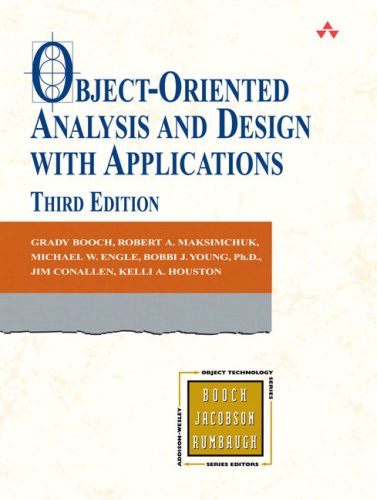Grady Booch, Robert A. Maksimchuk, Michael W. Engel, Bobbi J. Young, Jim Conallen, Kelli A. Houston020189551X, 9780201895513
The authors draw upon their rich and varied experience to offer improved methods for object development and numerous examples that tackle the complex problems faced by software engineers, including systems architecture, data acquisition, cryptoanalysis, control systems, and Web development. They illustrate essential concepts, explain the method, and show successful applications in a variety of fields. You’ll also find pragmatic advice on a host of issues, including classification, implementation strategies, and cost-effective project management.
New to this new edition are
An introduction to the new UML 2.0, from the notation’s most fundamental and advanced elements with an emphasis on key changesNew domains and contextsA greatly enhanced focus on modeling–as eagerly requested by readers–with five chapters that each delve into one phase of the overall development lifecycle.Fresh approaches to reasoning about complex systemsAn examination of the conceptual foundation of the widely misunderstood fundamental elements of the object model, such as abstraction, encapsulation, modularity, and hierarchyHow to allocate the resources of a team of developers and mange the risks associated with developing complex software systemsAn appendix on object-oriented programming languagesThis is the seminal text for anyone who wishes to use object-oriented technology to manage the complexity inherent in many kinds of systems.
Sidebars Preface Acknowledgments About the Authors Section I: Concepts Chapter 1: Complexity Chapter 2: The Object Model Chapter 3: Classes and Objects Chapter 4: Classification Section II: Method Chapter 5: Notation Chapter 6: Process Chapter 7: Pragmatics Chapter 8: System Architecture: Satellite-Based Navigation Chapter 9: Control System: Traffic Management Chapter 10: Artificial Intelligence: Cryptanalysis Chapter 11: Data Acquisition: Weather Monitoring Station Chapter 12: Web Application: Vacation Tracking System Appendix A: Object-Oriented Programming Languages Appendix B: Further Reading Notes Glossary Classified Bibliography Index
Amazon.com Review In this eagerly awaited second edition, Grady Booch draws upon the rich and varied results of those projects and offers improved methods for object development and a new, unified notation. With numerous examples implemented in C++, Booch illustrates essential concepts, explains the method, and shows successful applications in a variety of fields. Booch also gives pragmatic advice on a host of issues, including classification, implementation strategies, and cost-effective project management. A two-time winner of Software Development’s coveted Jolt Cola Product Excellence Award!
Table of contents :
Object-oriented analysis and design with applications, 3rd Edition……Page 1
Contents……Page 8
Sidebars……Page 12
Preface……Page 14
Acknowledgments……Page 20
About the Authors……Page 22
Section I: Concepts……Page 26
Chapter 1 Complexity……Page 28
1.1 The Structure of Complex Systems……Page 29
1.2 The Inherent Complexity of Software……Page 32
1.3 The Five Attributes of a Complex System……Page 37
1.4 Organized and Disorganized Complexity……Page 39
1.5 Bringing Order to Chaos……Page 43
1.6 On Designing Complex Systems……Page 49
2.1 The Evolution of the Object Model……Page 54
2.2 Foundations of the Object Model……Page 62
2.3 Elements of the Object Model……Page 68
2.4 Applying the Object Model……Page 96
3.1 The Nature of an Object……Page 100
3.2 Relationships among Objects……Page 113
3.3 The Nature of a Class……Page 117
3.4 Relationships among Classes……Page 121
3.5 The Interplay of Classes and Objects……Page 136
3.6 On Building Quality Classes and Objects……Page 137
4.1 The Importance of Proper Classification……Page 146
4.2 Identifying Classes and Objects……Page 151
4.3 Key Abstractions and Mechanisms……Page 163
Section II: Method……Page 170
5.1 The Unified Modeling Language……Page 172
5.2 Package Diagrams……Page 180
5.3 Component Diagrams……Page 188
5.4 Deployment Diagrams……Page 196
5.5 Use Case Diagrams……Page 200
5.6 Activity Diagrams……Page 210
5.7 Class Diagrams……Page 217
5.8 Sequence Diagrams……Page 231
5.9 Interaction Overview Diagrams……Page 238
5.10 Composite Structure Diagrams……Page 240
5.11 State Machine Diagrams……Page 243
5.12 Timing Diagrams……Page 256
5.13 Object Diagrams……Page 260
5.14 Communication Diagrams……Page 263
Chapter 6 Process……Page 272
6.1 First Principles……Page 273
6.2 The Macro Process: The Software Development Lifecycle……Page 281
6.3 The Micro Process: The Analysis and Design Process……Page 298
Chapter 7 Pragmatics……Page 328
7.1 Management and Planning……Page 329
7.2 Staffing……Page 333
7.3 Release Management……Page 337
7.4 Reuse……Page 339
7.5 Quality Assurance and Metrics……Page 341
7.6 Documentation……Page 345
7.7 Tools……Page 347
7.8 Special Topics……Page 349
7.9 The Benefits and Risks of Object-Oriented Development……Page 351
Section III: Applications……Page 356
Chapter 8 System Architecture: Satellite-Based Navigation……Page 358
8.1 Inception……Page 359
8.2 Elaboration……Page 372
8.4 Post-Transition……Page 396
Chapter 9 Control System: Traffic Management……Page 400
9.1 Inception……Page 401
9.2 Elaboration……Page 410
9.3 Construction……Page 421
9.4 Post-Transition……Page 436
Chapter 10 Artificial Intelligence: Cryptanalysis……Page 438
10.1 Inception……Page 439
10.2 Elaboration……Page 446
10.3 Construction……Page 452
10.4 Post-Transition……Page 471
Chapter 11 Data Acquisition: Weather Monitoring Station……Page 474
11.1 Inception……Page 475
11.2 Elaboration……Page 488
11.3 Construction……Page 499
11.4 Post-Transition……Page 512
Chapter 12 Web Application: Vacation Tracking System……Page 514
12.1 Inception……Page 515
12.2 Elaboration……Page 519
12.3 Construction……Page 531
12.4 Transition and Post-Transition……Page 559
A.1 Language Evolution……Page 562
A.2 Smalltalk……Page 566
A.3 C++……Page 571
A.4 Java……Page 576
Appendix B: Further Reading……Page 582
Notes……Page 592
A……Page 616
C……Page 617
F……Page 619
I……Page 620
M……Page 621
O……Page 622
P……Page 623
R……Page 624
S……Page 625
T……Page 626
V……Page 627
Classified Bibliography……Page 628
A……Page 702
C……Page 703
D……Page 705
E……Page 706
H……Page 707
K……Page 708
M……Page 709
O……Page 710
P……Page 711
S……Page 712
T……Page 714
V……Page 715
Z……Page 716







Reviews
There are no reviews yet.